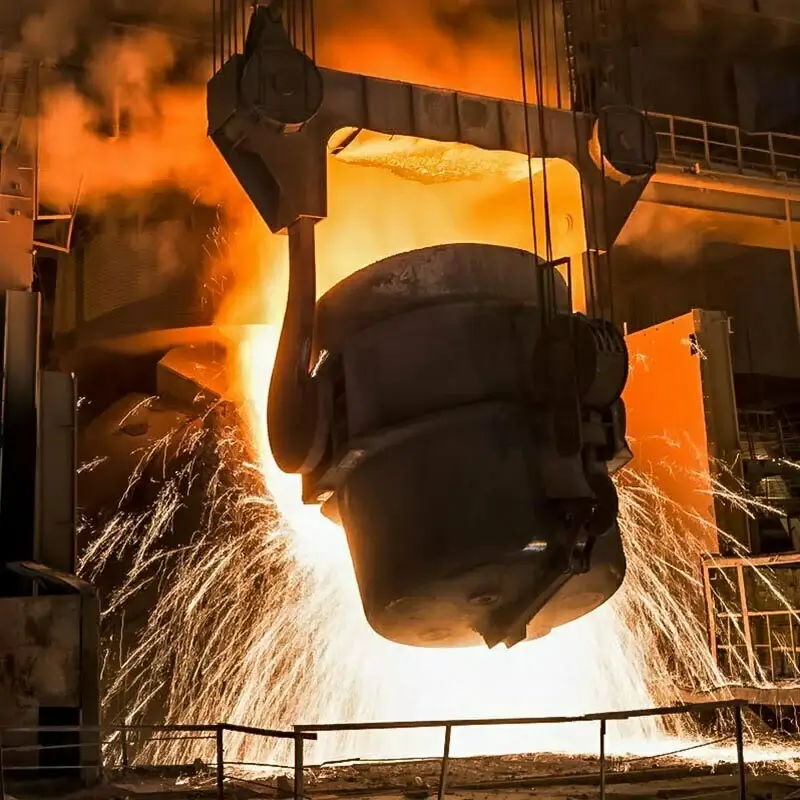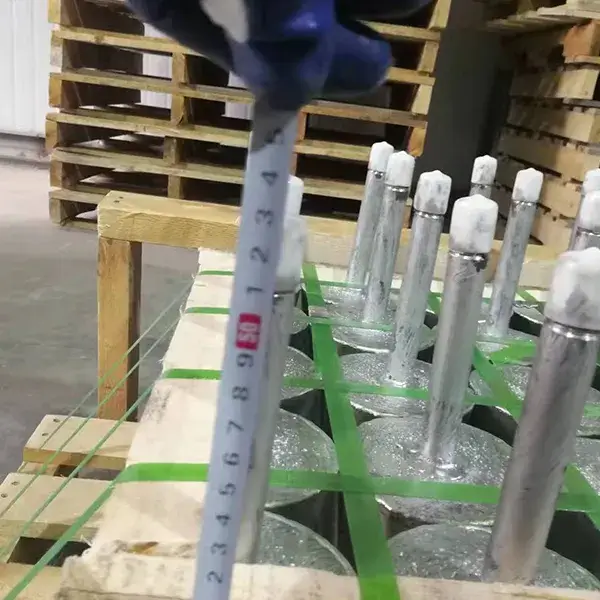External refining is a new metallurgical process that has developed in recent years. It involves moving almost all or part of the refining tasks typically performed in a melting furnace, such as degassing, impurity removal, and composition and temperature adjustment, outside the furnace. External refining is also known as secondary steelmaking, and because the molten steel is mostly refined within the ladle, it is also called ladle metallurgy.
During the external refining process, the refractory materials used in the ladle, air bricks, and lances are subjected to extremely harsh operating conditions, resulting in severe erosion or corrosion of the refractory materials. Therefore, careful selection of refractory materials is crucial.
1.Ladle lining refractory materials
Traditionally, the ladle is a storage and transportation container between the steelmaking furnace and the ingot. However, refining outside the furnace is further refining in the ladle. Therefore, the service conditions of the ladle lining are greatly deteriorated. The temperature of the molten steel increases, the residence time in the ladle is prolonged, and the erosion and corrosion of the refractory materials by the molten steel and slag are more serious. The previous refractory materials cannot meet the needs of refining outside the furnace. Therefore, my country has developed a variety of refractory materials for ladle lining to meet the needs of steel mills. The main types are as follows:
(1) Aluminum-magnesium-carbon bricks
After Baosteel tried the use of aluminum-magnesium-carbon bricks in its 300t ladle in 1990, it was quickly promoted to many steel mills and became the main refractory material for the lining of large and medium-sized ladles in my country. At the time, Baosteel’s 300t ladle cladding used aluminum-magnesium-carbon bricks, and the slag line used magnesium-carbon bricks. The tapping temperature was 1660-1670°C. The molten steel was subjected to RH vacuum degassing within the ladle, and KIP and CAS refining treatments were applied. The aluminum-magnesium-carbon bricks had only a thin layer of slag on their surface, offering excellent corrosion resistance, no slag penetration, no thermal shock damage, and uniform corrosion. Their service life averaged 80 cycles, with a maximum of 126. Aluminum-magnesium-carbon bricks are unfired refractory products formed from a mixture of high-alumina clinker, magnesia sand, graphite, antioxidants, and a phenolic resin binder. Their relatively simple manufacturing process and low cost made them readily accepted by users.
(2) Aluminum-magnesium spinel castables
In the mid-1990s, to accommodate refining outside the furnace, some large and medium-sized ladles adopted high-grade aluminum-magnesium spinel castables for lining. The raw materials used were fused corundum, sintered corundum, high-purity fused magnesia, and high-purity aluminum-magnesium spinel, and the castables were combined with pure calcium aluminate cement, high-purity SiO2, and Al2O3 micropowders. Baosteel’s 300t ladle was in use until 2000, with an average lifespan of 258 cycles; Shougang’s 90t LF refining ladle had a lifespan of 138 cycles, with an erosion rate of 0.62 mm/cycle; and the prefabricated parts used by Benxi Steel had a lifespan of 118 cycles, with a maximum of 126 cycles.
(3) Magnesium-calcium refractory materials
Taiyuan Steel used ordinary dolomite as raw material and medium-temperature asphalt-bonded dolomite ramming material on a 70t ladle, with an average lifespan of 76 times and a maximum of 112 times. Luoyang Refractories Institute used synthetic magnesia-calcium sand and fused magnesia sand as raw materials, solid inorganic salts and inorganic salt solutions as binders, and developed unburned magnesia-calcium bricks. These bricks were used on a 40t LF-VD refining ladle, with a lifespan of more than 40 times, and the oxygen content in the steel decreased from 12.2×10-6 At the beginning of the 21st century, Shougang developed unburned magnesia-calcium carbon bricks using synthetic magnesia-calcium sand, fused magnesia and high-purity graphite as raw materials and anhydrous resin as binder. They were used in the non-slag line area of 225t ladle (magnesia-calcium bricks were used in the slag line area), with an average lifespan of 116.8 times. Compared with the original aluminum-magnesia carbon bricks, the average lifespan increased by 35.57 times when the ladle wall was thinned by 20mm, and the oxygen content and non-metallic inclusions in the steel were reduced. Some steel mills also used magnesia-calcium carbon bricks in the slag line area of various ladles such as SKF and LF-VD, and achieved good results.
(4) Reduce refractory consumption in refining ladles
Over 70% of my country’s steel ladles are refined, and ladle refractory consumption accounts for over 30% of the total refractory consumption in the steel metallurgical industry. As the refining ratio increases, the unit consumption of refractory in ladles increases. my country’s refractory consumption is generally considered to be around 20kg/t steel, while in advanced countries it is 6-8kg/t steel. Reducing refractory consumption in ladles plays an important role in reducing costs, energy conservation, and emissions.
The slag line uses 66% recycled magnesia carbon bricks, and the melt pool uses 88% recycled alumina magnesia carbon bricks. Measures to reduce unit consumption are: design magnesia carbon bricks according to the ladle operating conditions; increase the calcium content in the slag to reduce the erosion rate. The early slag of the ladle has a high FeO content, which makes the carbon in the bricks easily oxidized. To improve the oxidation resistance of magnesia carbon bricks, additives that increase the viscosity of fluorite slag are used. In order to reduce costs, post-spent magnesia carbon bricks are selected; improve operating conditions, adopt the slag retention operation after steelmaking, and reduce the FeO content in the slag by improving foam slag and other methods, which increases the life of the ladle by 20%; do not use SiC deoxidizers, but instead use magnesia calcium carbon ladle modifiers with a carbon content of 15% (w), which increases the life of magnesia carbon bricks in the slag line by 15%; improve the maintenance system, use 40mm thick secondary high-alumina bricks to patch the melt pool, and increase the life by more than 45%. In this way, the life of the ladle is increased from 40 to 50 times to 88 times. After deducting the use of recycled materials, the resource consumption of refractory materials per ton of steel is reduced from 9.3 kg to 1.4 kg, a decrease of 85%.
2.Argon-blown breathable bricks
The ladle bottom argon blowing process is widely used in refining, and air bricks are a key functional refractory material in this process. Currently, air bricks at the ladle bottom are a bottleneck limiting the lifespan of the ladle. Air bricks are used intermittently and repeatedly. Among the many factors that affect the service life of air bricks, thermal spalling and oxygen purging are the main causes of damage. Air bricks are primarily made of chrome corundum and corundum-spinel, and are typically cast and fired at high temperatures. Because chrome corundum forms hexavalent chromium during high-temperature firing, which pollutes the environment, it is gradually being replaced by corundum-spinel. To improve the service life of air bricks, measures such as optimizing the ingredient composition, adjusting the cement content to adjust the CaO content in the castable matrix to increase the formation of Ca6 in the matrix, improving thermal shock resistance and strengthening the structure, adjusting the spinel particle size and addition amount, adding an appropriate amount of ZrO2 or zirconium corundum, and optimizing the firing temperature can optimize the performance of air bricks.
There are also corundum breathable bricks combined with non-oxides (Si3N4; Sialon). Field use shows that they have excellent thermal shock resistance and are non-wetting with molten steel. During use, they have a high blow-through rate, are easy to clean with oxygen blowing, have a low erosion rate, and their service life is greatly improved.
3.Refractory materials for spray guns
Powdered treatment agents are injected into the molten steel via a spray gun to refine it. For example, in the SL process, the powdered refining agent, CaSi, is injected into the molten steel using argon gas through a spray gun inserted deep within the ladle. Gas agitation ensures thorough mixing and reaction between the refining agent and the molten steel. The refractory materials in spray metallurgy spray guns operate under demanding conditions, including high molten steel temperatures and severe slag erosion and thermal shock damage. The integrated spray gun structure developed by the Luoyang Institute of Refractories uses a corundum castable at the slag line and a castable with an Al2O3 content of 70% to 80% above and below the slag line. Used in a 40t SL spray metallurgy unit, the spray gun has a service life of 15 to 19 operations, with a total spraying time of 95 minutes. Baosteel’s spray guns use fused corundum with an Al2O3 content of at least 99% and a refractory castable reinforced with heat-resistant steel fibers. The service life is 10 to 20 operations, with a total blowing time of 100 minutes per gun, with a maximum of 188 minutes per gun.

